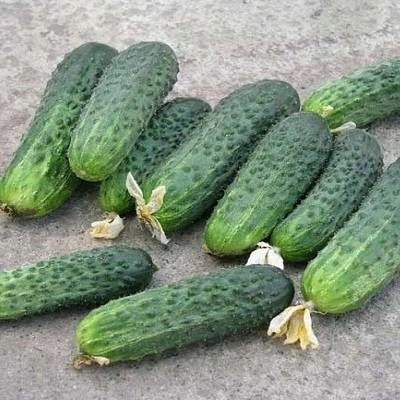
- Authors: Gavrish S.F., Portyankin A.E., Shamshina A.V., Shevkunov V.N., Khomchenko N.N., Surovova T.Ya., Pluzhnik I.S.
- Year of approval: 2011
- Growth type: vigorous, indeterminate
- Branching: weak
- Fruit weight, g: 120-130
- Fruit length, cm: 10-12
- Fruit color: dark green with short stripes and sparse mottling
- Ripening terms: early
- Fruit shape: cylindrical
- Fruit taste: great
Many gardeners believe that the earlier the vegetables ripen, the better. Cucumbers are no exception. Hybrid Emerald Family F1 is ready for use in a month and a half. And besides, the cucumber hybrid is high-yielding and resistant to major diseases.
Breeding history
The well-known seed company "Gavrish" became the originator of the hybrid variety Emerald family. A large team of specialists worked on the creation of culture: Gavrish S., Portyankin A., Shamshina A., Shevkunov V., Khomchenko N., Surovova T., Pluzhnik I.
In 2011, the hybrid was introduced to Rosreestr almost immediately after filing an application for admission and was recommended for cultivation in spring unheated greenhouses under film in private household farms.
Description of the variety
Parthenocarpic hybrid variety Emerald family does not need insects for pollination. The culture has been adapted to almost all climatic zones of the Russian Federation. Demonstrates high productivity. And also suitable for planting in open beds, and for greenhouse cultivation. Plants are resistant to a variety of diseases. Cucumbers are happily cultivated by amateur vegetable growers in their summer cottages, backyards, and farmers in large farms.
Characteristics of the appearance of plants and zelents
The plant is quite tall and belongs to indeterminate crops. The height must be limited to 2 meters. The bush is weakly branched, bundle or bouquet ovaries are formed on it, up to 5 cucumbers develop in each. Since it is a parthenocarpic species, it is mainly a female type.
Zelentsy are painted in a dark green hue; you can see weak stripes on them. The shape is cylindrical, elongated. Large tubercles are located on the skin, there is a slight ribbing, the thorns are white. Cucumbers are 10-12 cm long, their diameter is 3.5-4 cm.The weight of zelents is from 120 to 130 g.
Purpose and taste of fruits
They note the excellent taste of the Emerald Family Zelens, which is distinguished by a sweetish aftertaste and fresh aroma. Their purpose is universal, that is, cucumbers can be pickled, pickled, used for fresh salads, slicing. Ripe fruits are well stored, tolerate transportation well, without loss of taste and presentation.
Maturation
The crop of zelents of the culture in question can be harvested 40-43 days after the first seedlings have sprung up.
Yield
The emerald family belongs to high-yielding varieties - on average, 14.6-15.8 kilograms of cucumbers can be removed from 1 m2.
Growing regions
The domestic hybrid has been successfully grown for 10 years in such regions as the northern and Northwestern, Central and Central Chernozem, Volgo-Vyatka, as well as in the North Caucasus, the Middle and Lower Volga, in the Urals, in Siberia, in the Far East.
Landing scheme
Options for planting a hybrid Emerald family: 50x50 cm, 30x70 cm.
Growing and care
The growth of the hybrid variety will continue throughout the growing season.Therefore, it is necessary to pinch the crown of the head upon reaching the two-meter mark and make a garter. The lateral shoots of the culture are not very branching, but to increase their yield, they must be pinned.
In addition to tying and pinching, the Emerald Family hybrid will need simple care activities, including watering, loosening, feeding and treating diseases and pests. Even beginner gardeners can handle the cultivation of such cucumbers.
Like all cucumbers, the variety in question is hygrophilous, does not tolerate drought well, but at the same time will not tolerate water accumulation. Watering should only be done with warm, settled water. The event is held in the early morning (before the heat) or in the evening, when it is already not hot. The ideal solution is drip irrigation.
The indeterminate plant, which is the Emerald Family hybrid, needs additional support. The branches are tied up with a cotton cord or hemp to a horizontal trellis.
Loosening the soil after watering or rains helps to avoid crusting on the surface of the earth, making the soil more air and water permeable. However, this must be done very carefully so as not to harm the roots.

In order to collect strong, tasty and beautiful cucumbers on your site, you need to make top dressing. Lack of nutrients can negatively affect the appearance of the plant and significantly reduce the yield. Fertilize cucumbers with organic fertilizers in combination with mineral fertilizers. With the right balance of these components and adherence to the fertilizing schedule, the cucumber yield will be maximum.
Disease and pest resistance
The hybrid Emerald family shows good resistance to diseases such as powdery mildew, olive spot. Medium resistant culture to downy mildew.

Despite their popularity, cucumbers are often attacked by diseases and pests. From them, cucumber plantings often die before the start of fruiting. In order to prevent this from happening, it is necessary to try to prevent ailments or get rid of them at the very beginning, having studied in detail their causes of occurrence, signs and methods of treatment.





























































































